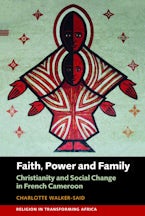Contemporary observers, and later historians, of the colonial-era indigenization of Christianity in Africa have long recognized that local evangelists and catechists, rather than the missionaries, did much of the grueling fieldwork of the church, covering vast distances, articulating the message in multiple vernaculars, and more. It was these mostly forgotten African Christian leaders who innovated, experimented, and contextualized, and not infrequently faced heat from colonial and traditional authorities alike.
In Faith, Power and Family: Christianity and Social Change in French Cameroon, an authoritative social and religious history, Charlotte Walker-Said foregrounds these catechists’ work, naming several, and repeatedly demonstrating their intellectual vitality, dynamic leadership, and (most intriguingly) autonomy from missionary control. The quarter century following the onset of the First World War saw tremendous social and religious change in the region, as “Africans in Cameroon experienced the upheaval attendant with Christian conversion most frequently and poignantly in their family lives” (2).
Cameroon’s context is unique: as a German colony until World War One, the invading French and British deported German citizens (including missionaries of all denominations). This invasion and occupation constituted a natural experiment of sorts: with the foreign messengers artificially absent, would the locals assume leadership, or would they walk away from the foreigners’ religion? Walker-Said’s argument is clearly the former. Absent missionary control, the catechists exploited to the full their freedom.
Preaching, teaching, hearing confessions, and taking care of small Christian communities scattered by the war (often having retreated to the remotest forest settlements), indigenous catechists and evangelists gathered and reconstituted their charges into healed and growing communities—and with tremendous growth as a result. Beyond the sacramental layer of agency, interwar Cameroonian Christians found opportunities for leadership in church-related volunteer organizations such as the Blue Cross temperance society and various Catholic confraternities. All told, Walker-Said concludes, as indigenous Christians seized initiative over problems they had identified as urgent, “most foreign missionaries were relegated to the margins of pastoral work while Africans devoted themselves to activism and intercession on behalf of believers in distress” (206).
In Walker-Said’s treatment, most foreign missionaries come off as generous and good—which might not have been very difficult when compared with the perennially ham-fisted colonial administration. Unable to comprehend the dynamism of social and cultural change underway, French authorities, in Walker-Said’s delicious words, “worked on an antipodean aim” from that of African Christians, consistently promoting as chiefs whichever local notables could best maintain a social order that had never really existed in the first place (206). In practice this policy meant that the colony chose pliant men without scruples who could guarantee the requisite number of young men sent out for roadwork each year.
Some chiefs took advantage of the colonial government’s program of mandatory roadwork, a policy which effectively exiled young men long distances from their villages. With their potential rivals away for months on end, chiefs could marry all local girls (some prepubescent) and women; the author mentions several cases of chiefs with dozens and even hundreds of wives. Such hoarding was, in practical terms (as many of these chiefs were too old to couple with them in the usual way), agricultural slavery: the chiefs were often marrying in order to staff their cocoa or coffee plantations.
Meanwhile, unable or unwilling to comprehend these corruptions as deriving directly from their own policies, the French colonial authorities dug in, “seeking to reinforce manufactured political hierarchies, even as they faced increasing resistance from local populations” (232).
Catechist protests against chiefly hoarding of women, which emerged in the 1920s, escalated in intensity in the 1930s, sometimes coming to brawling, murder, and police sexual assaults of girls sheltering in church homes (so-called sixas, familiar to readers of Mongo Beti’s 1956 protest novel The Poor Christ of Bomba). At issue, Walker-Said argues, was an emergent indigenous Christian social vision of the family, centered on male authority: “the power to form a family and an independent household.” However, the author continues, “in practice, access to wives became the epicenter of religious politics in southern Cameroon” (229). Accordingly, the same catechists who marshalled a general rebellion against chiefly polygamy also “practiced a politics of virtue whereby they assumed authority over everyday followers,” including over sexual infractions (248).
The book is tightly organized in two groups of chapters, each group covering roughly fifteen years. However, the author’s organization is more thematic than chronological, progressing from the initial vacuum of authority created by the First World War and filled by hundreds of self-motivated catechists, through to these young leaders’ maturation as leaders and their ensuing conflicts both with chiefs and colonial administrators. This thematic organization works best when the author turns to case studies, some several pages in length, and others only a few sentences. These stories—often of married couples struggling to meet all the pressures upon their lives—are what make the book hold together; it’s what makes this study so moving.
Walker-Said’s sources are a mixture of governmental and church archives both in Cameroon and France, complemented by well-chosen oral interviews. The author rewards the reader of at times discursive footnotes with some of her more pugnacious interventions, dismissing notable scholars, usually for unwarranted generalizations.
One thread of inquiry, generally missing here but which might have been helpful, would have been a conversation about laïcité, the established French form of secularism that had been promulgated in France a quarter century earlier, and which had a decidedly anticlerical (especially anti-Catholic) quality. Elsewhere in Africa (including in adjacent Gabon), the French continued to use Catholicism as part of a broader civilizing mission long after such policies were unthinkable back home. One wonders whether and how conflict between Cameroonian catechists and colonial administrators reflects these empire-wide republican contradictions.
Paul Glen Grant is a lecturer in the Department of History at the University of Wisconsin-Madison.
Paul Glen Grant
Date Of Review:
August 25, 2022

